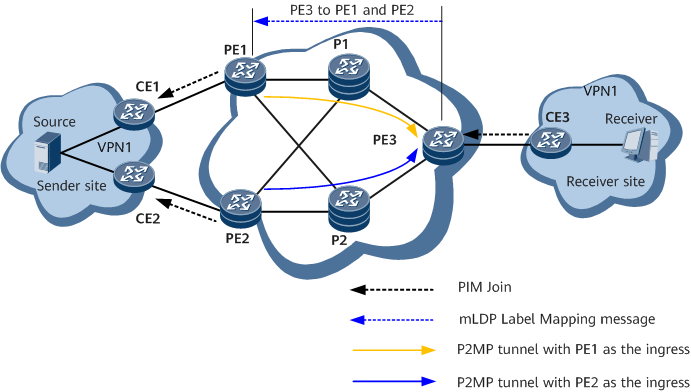mLDP In-Band MVPN Reliability
MDT protection prevents lengthy multicast service interruptions caused by a node or link failure on a network. Node or link redundancy offers a general protection mechanism, whereby traffic can immediately switch to a backup device or link if the primary device or link fails. mLDP in-band MVPN supports traffic detection-based dual-root 1+1 protection.
- It mainly uses traffic detection to detect link failures, ensuring fast convergence and high reliability.
- Redundant multicast traffic exists on the network, wasting bandwidth resources.
- Only sender PEs and public network tunnels can be protected, whereas receiver PEs and CEs cannot be protected.
Two sender PEs (PE1 and PE2) are configured for an MVPN. mLDP P2MP is configured on PE1 and PE2 so that two mLDP P2MP tunnels (rooted at PE1 and PE2, respectively) can be established, with PE3 as a leaf node.
VPN FRR is configured on PE3 so that PE3 can have two routes to the same multicast source. PE3 uses the route advertised by PE1 as the primary route, and that advertised by PE2 as the backup route.
Traffic detection-based C-multicast FRR is configured on PE3.
Normal scenario
- The process for a user to join a multicast group is as follows: CE3 sends a PIM Join message to PE3, which converts the information in the message into the Opaque value of an mLDP Label Mapping message and uses signaling information to establish mLDP tunnels to PE1 and PE2. PE1 and PE2 convert the mLDP message to a PIM Join message, and send the PIM Join message to the corresponding CEs. In this way, the user joins the multicast group.
- The multicast forwarding process is as follows: After receiving multicast traffic from the multicast source, PE1 sends it to PE3 over the mLDP P2MP tunnel. Upon receipt, PE3 sends the traffic to CE3, which in turn sends it to the multicast receiver. The multicast traffic received over the backup tunnel (mLDP P2MP tunnel rooted at PE2) is discarded.
Fault scenario
A node or public network tunnel may fail on the network shown in Figure 1. If PE1 or the tunnel (primary tunnel) passing through PE1 fails, PE3 can quickly detect the interruption of the traffic transmitted over the primary tunnel through traffic detection and accepts the multicast traffic received over the backup tunnel.
When a fault occurs on the public network tunnel, P1, or the link where P1 resides, the processing procedure is the same as the preceding procedure.
